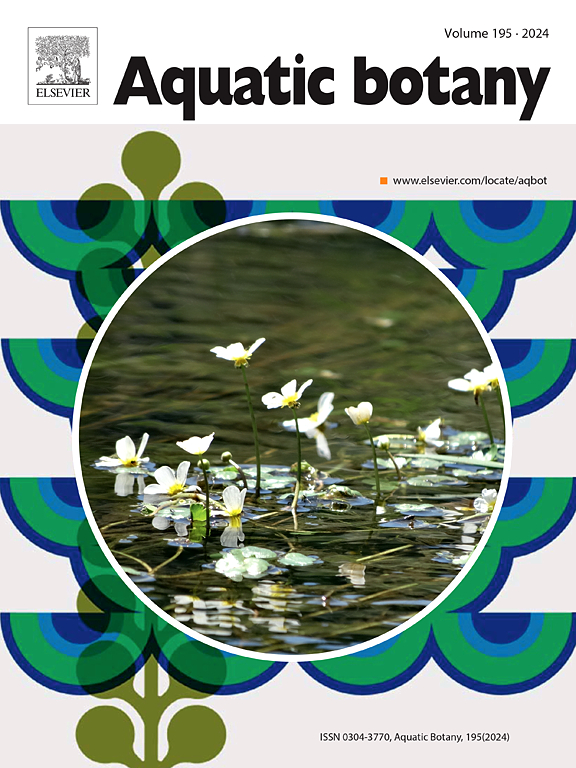Fine-scale patterns and drivers of ploidy state in lentic and lotic macrophyte assemblages across the world
IF 2.6
4区 生物学
Q2 MARINE & FRESHWATER BIOLOGY
引用次数: 0
Abstract
To investigate whether patterns of ploidy state variation known to occur in macrophytes at broad global scales can be detected at finer site scale, we examined macrophyte assemblages present in 1239 individual inland lentic and lotic waterbodies sampled from 2000 onwards. The sites include lakes and reservoirs, rivers and streams, slow-flowing or static water bodies associated with rivers (such as oxbows), man-made channels, and temporary or ephemeral lentic waterbodies in 22 countries worldwide. The latitude range for these sites was 10.58–68.40° N and from 0.01 to 54.88° S, covering climatic conditions ranging from tropical to temperate/Arctic. We examined the influence of geospatial variables, current or historic climate variables, and additional local water physical and chemical variables measured for each site, as potential predictors of the incidence of ploidy state (diploidy, polyploidy, and mixed-cytotype) in the macrophyte species assemblage. At fine scales (individual sites), we observed the same latitudinal and climatic patterns influencing all macrophyte ploidy states, especially diploid species, compared to findings at a broad spatial resolution of 10° × 10° latitude-longitude. Ploidy state of macrophyte assemblages slightly, but significantly, differs between lentic and lotic environments. Along with geospatial and climate variables, local physical and chemical variables also helped predict the occurrence of polyploid and mixed-ploidy species. Our results support previous findings on ploidy state distribution and drivers at broader scales but also unravel new information on key drivers for the distribution of polyploid and mixed-ploidy species, relevant to understanding macrophyte adaptation mechanisms and evolutionary processes worldwide.
世界各地大型植物组合中倍性状态的精细尺度模式和驱动因素
为了研究在全球范围内已知的大型植物倍性状态变异模式是否可以在更精细的地点尺度上检测到,我们研究了2000年以来采样的1239个内陆湖泊和湖泊水体中存在的大型植物组合。这些遗产地包括遍布全球22个国家的湖泊和水库、河流和溪流、与河流相关的缓慢流动或静态水体(如牛轭)、人工河道以及临时或短暂的静态水体。这些站点的纬度范围为北纬10.58 ~ 68.40°和南纬0.01 ~ 54.88°,气候条件从热带到温带/北极。我们研究了地理空间变量、当前或历史气候变量以及在每个站点测量的额外的当地水物理和化学变量的影响,作为大型植物物种组合中倍性状态(二倍体、多倍体和混合细胞型)发生率的潜在预测因子。与10°× 10°纬度-经度的宽空间分辨率相比,我们观察到相同的纬度和气候模式影响所有大型植物的倍性状态,特别是二倍体物种。大型植物组合的倍性状态在原生环境和原生环境之间有轻微但显著的差异。除了地理空间和气候变量外,当地的物理和化学变量也有助于预测多倍体和混合倍体物种的发生。我们的研究结果支持了先前在更大范围内关于倍性状态分布和驱动因素的发现,同时也揭示了多倍体和混合倍体物种分布的关键驱动因素的新信息,这与理解全球范围内的大型植物适应机制和进化过程有关。
本文章由计算机程序翻译,如有差异,请以英文原文为准。
求助全文
约1分钟内获得全文
求助全文
来源期刊

Aquatic Botany
生物-海洋与淡水生物学
CiteScore
3.80
自引率
5.60%
发文量
70
审稿时长
6 months
期刊介绍:
Aquatic Botany offers a platform for papers relevant to a broad international readership on fundamental and applied aspects of marine and freshwater macroscopic plants in a context of ecology or environmental biology. This includes molecular, biochemical and physiological aspects of macroscopic aquatic plants as well as the classification, structure, function, dynamics and ecological interactions in plant-dominated aquatic communities and ecosystems. It is an outlet for papers dealing with research on the consequences of disturbance and stressors (e.g. environmental fluctuations and climate change, pollution, grazing and pathogens), use and management of aquatic plants (plant production and decomposition, commercial harvest, plant control) and the conservation of aquatic plant communities (breeding, transplantation and restoration). Specialized publications on certain rare taxa or papers on aquatic macroscopic plants from under-represented regions in the world can also find their place, subject to editor evaluation. Studies on fungi or microalgae will remain outside the scope of Aquatic Botany.
 求助内容:
求助内容: 应助结果提醒方式:
应助结果提醒方式:


